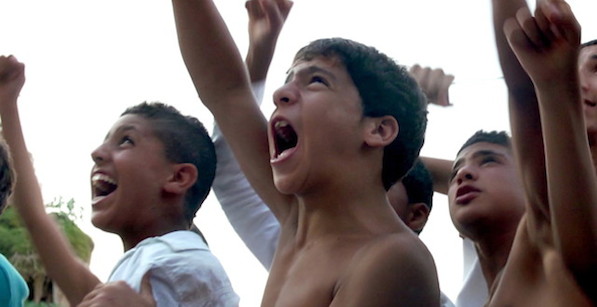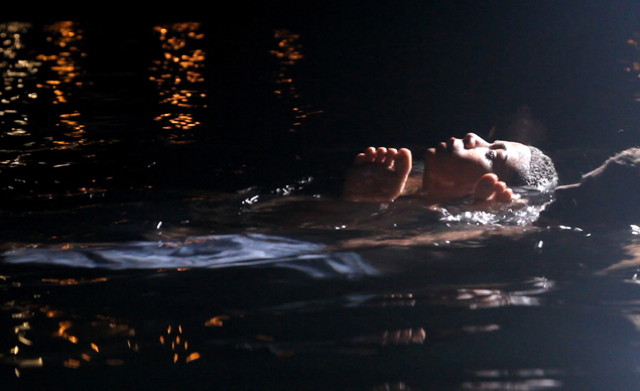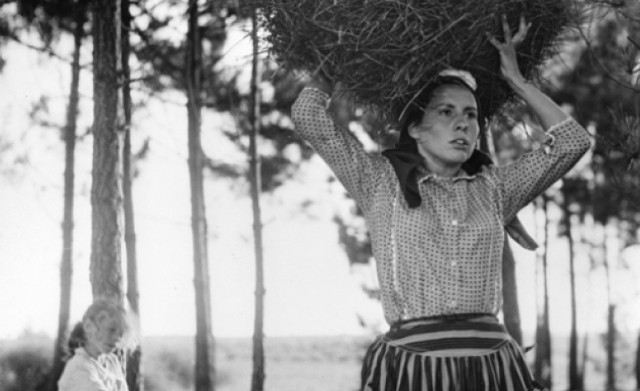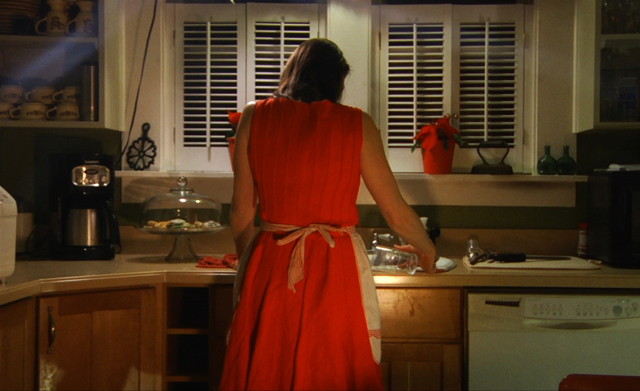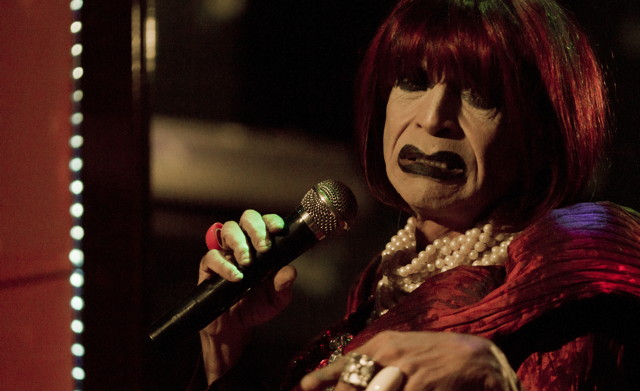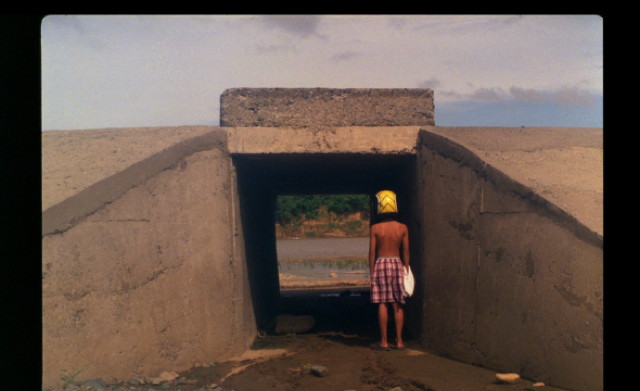The time has come for a festival like the Film Society of Lincoln Center’s Art of the Real, which runs from April 11-26. It resembles a scaled-down version of Columbia, Missouri’s True/False film festival, but its stated orientation is “reality,” not “documentary.” This is a series for people whose favorite documentary is F For Fake, not a Ken Burns production. Most of its films are a hybrid of non-fiction, essay and narrative. Art of the Real isn’t afraid to include completely fictional films.
It must be said that this approach to curating, as daring as it is, parallels the building trend in documentary itself, where fictional techniques and dramatic creations (as well as re-creations) are a reigning trend. Where Errol Morris‘s inclusion of re-creations in The Thin Blue Line was exceptional in its time The Act of Killing and The Missing Picture, documentaries which incorporate elements of fiction in very different ways, both got Oscar nominations. And Stories We Tell, which also appropriates fictional techniques, was a critical and commercial success. Critical hit Leviathan drew on avant-garde cinema of the late sixties and early seventies. (The festival has a large retrospective of films produced selected by filmmakers of Harvard’s Sensory Ethnography Lab, the source of Leviathan.)
Art of the Real isn’t afraid of politics—for example, it includes a revival of Thom Andersen and Noel Burch’s 1996 Red Hollywood—but it avoids issue-driven documentaries, as well as profiles of well-known artists (or even cult performers like Searching for Sugar Man subject Rodriguez.) The festival also draws from filmmakers usually not considered in the documentary context (Lisandro Alonso), left aside to the art world (Amie Siegel) or avant-garde niche (James Benning). However, it’s a testament to the blurring of lines between documentary and fiction that it could find enough films to fill a festival. Indeed, a friend of mine praised Particle Fever for its old-fashioned respect for documentary purism.
The best film I was able to preview, Algerian director Narimane Mari’s Bloody Beans shows the insight that fantasy can bring to reality. It’s full of blatant anachronisms like a techno-inspired electronic soundtrack coupled with a setting that suggests the early sixties. No one seems capable of talking about Bloody Beans without mentioning Lord of the Flies and its ragtag band of feral children, who find their mirror image in Mari’s gang of Algerian beach dwellers. Parents do exist here, but they’re almost never seen or heard. The youth of Bloody Beans’ characters doesn’t prevent them from engaging in radical anti-colonial struggle, as the film restages Algeria’s war for independence from France in a new context. There’s no central character; instead, the kids function like a swarm, making decisions without a leader. They wind up kidnapping a French soldier and trying to teach him what it’s like to be Algerian by feeding him beans. Mari avoids the dry cant of much political discourse by staging her film in such an unconventional setting. She also has an amazing eye for nocturnal imagery: Bloody Beans is full of haunting scenes such as the one in which a group of kids float on their backs in the ocean. She never sets herself up as a voyeur or moralist, a la Larry Clark. Relying heavily on its score and the actors’ energy, the film has a flow and sense of danger—so often aimed for by films about youth rebellion, so seldom achieved—that sets it closer to controversial teenage rapper Chief Keef’s music videos, in which shirtless boys hang out, smoke pot and wave guns around, than Gillo Pontecorvo’s The Battle of Algiers.
Seen in 2014 America, the exact relation of Paulo Rocha’s 1966 Change of Life to reality is a puzzle. The film draws more heavily on neorealism than the documentary tradition—in fact, its only non-fiction elements may be scenes of fishermen at work. Rocha’s states his inspiration as Manoel de Oliveira, but comes closer to early Luchino Visconti. Change of Life chronicles a soldier’s return to his hometown in Portugal after a tour of duty in Africa. He discovers that his wife has slept around during his absence, while a back injury sustained in Africa has hurt his ability to work. The narrative and dialogue are melodramatic, while the images offer a connection to reality. In truth, it made me long for Visconti’s La terra trema.
Robert Greene’s Actress shares its name with a great, genre-bending film by Hong Kong director Stanley Kwan. It focuses on Brandy Burre, an actress who had a small role on The Wire but gave up her craft to become a homemaker in suburban Beacon, New York. Actress alternates between long stretches that could pass for cinéma vérité and attempts to set Brandy’s life in a fantasy context, perhaps suggesting her subjectivity. Greene glamorizes scenes of such everyday tasks as Brandy handing her daughter a coathanger with slow motion, soft focus and tolling bells or chamber music. There’s only one overt attempt at fictionalization, when Brandy repeats the same lines to the camera twice, but we never forget that Actress is one of a long line of films about the struggles of actresses, almost all of them narrative. Without pushing too hard, Actress points out the uphill road a woman over thirty five faces in Hollywood, yet Brandy’s worst adversary may be herself. Unless she’s extremely lucky, she may be remembered more for Greene’s film than any fictional role.
Davi Pretto’s Castanha offers a look at acting from a different perspective. Its protagonist, Joao Carlos Castanha da Silva, is a middle-aged gay Brazilian actor who lives with his elderly mother. To make ends meet, Castanha performs as a drag queen MC at local gay strip clubs, in addition to acting in theater and small roles in films. At first, Castanha seems like a fairly standard observational documentary—at least after one gets over the shock of its opening, unexplained images of a naked man, covered in blood, walking down a road, clutching his crotch. It follows Castanha as he takes care of his mother and goes about his nighttime duties, putting on makeup and a wig. Pretto shows great subtlety in the way he lets themes emerge: mortality becomes one of the film’s main preoccupations, and not just because AIDS killed off much of Castanha’s generation of gay men. Castanha himself seems to be suffering from an unnamed illness, possibly lung cancer. About two-thirds of the way through, it becomes apparent that Castanha couldn’t possibly be a conventional documentary—there’s way too much melodrama in its DNA for that, especially in the subplot regarding Castanha’s crack-addicted nephew, and too many scenes in which material from Castanha’s art bleeds over into his life. Pretto does a terrific job of seamlessly integrating fiction and non-fiction.
In Time Goes by Like a Roaring Lion, German director Philipp Hartmann constantly speaks about himself, yet at the end of the film, one gets the sense that he really hasn’t revealed much. Time Goes by Like a Roaring Lion begins with a montage of family photos, taken by Hartmann’s late father, whose lefthand portion is a white blur. The film is concerned with time and death, and it explores these subjects by interviewing Hartmann’s friends and consulting experts. Unfortunately, Hartmann has a soundbite sensibility, leaping from one idea to the next without delving very deeply into any of them. Perhaps this accounts for the feeling that he’s playing coy with his own life. Time Goes by Like a Roaring Lion does have an attractive look, integrating glossy footage shot in German laboratories, the Bolivian salt desert, fictional recreations of the lives of his friends and home movies. However, Hartmann always maintains a distance, generally refraining from too many close-ups of people. At the same time, the very structure of his film is based around his life. Its seventy-six-minute running time is taken from the average life expectancy of the German male, and at the thirty-eight-minute mark, Hartmann suddenly introduces present-day footage of himself. Time Goes by Like a Running Lion could have been a more stimulating cinematic essay if it had more of a Chris Marker attention span.
Filipino director John Torres’ Lukas the Strange creates its own hermetic universe. Unfortunately, that world isn’t particularly seductive; indeed, it’s practically impenetrable. Seemingly structured around the disappearance of Lukas, a thirteen-year-old boy, during a movie shoot, it suggests, at various times, a coming-of-age tale, a reflection on the power of filmmaking or a mystery. Torres’ style recalls the faux-naive tone of Filipino precursor, Kidlat Tahimik. However, Lukas the Strange suffers from ugly, milky and blown-out cinematography. Even at its most coherent, it covers ground well trod by Iranian films like Jafar Panahi’s The Mirror and Mohsen Makhamalbaf’s A Moment of Innocence. Lukas the Strange shows the dangers of combining reality and fiction: this kind of hybrid has become a genre like any other, and trying to set oneself apart by upping the weirdness quotient comes with its own pitfalls.

